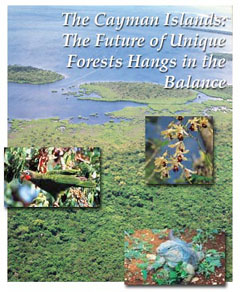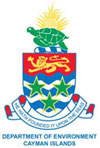|
The Cayman Islands:
The Future of Unique Forests Hangs in the Balance
The three low-lying Cayman Islands are strung along a submarine mountain ridge south of Cuba, west of Jamaica. The rapidly increasing human population is concentrated in Grand Cayman. Environmental conservation is shared between the National Trust for the Cayman Islands and the local Department of Environment.
The Cayman Islands are clothed in subtropical dry forests and mangrove wetlands, supporting diverse life typical of the Greater Antillean region.
Economic success and exponential population growth are taking a toll on the Cayman Islands, with ongoing deforestation threatening areas such as mangrove wetlands and ancient dry forests on all three islands. The National Trust for the Cayman Islands is working to establish a protected area system, giving priority to areas rich in biodiversity. Land owned by the Trust is protected in perpetuity. Trust nature reserves include the Booby Pond Nature Reserve on Little Cayman, a "Ramsar" Conservation Wetland of International Importance, home to 20,000 red-footed boobies. The Brac Parrot Reserve protects forest important for nesting of Cayman Brac’s critically endangered parrots. The Salina Reserve, Mastic Reserve and Central Mangrove Wetland (pictured) on Grand Cayman protect a wide range of pristine forest environments. The Trust works also to preserve species like the endangered blue iguana, which is making a comeback from the brink of extinction thanks to captive breeding and restocking of protected habitat.
The Blue Iguana Recovery Programme was established in 1990 and is now a partnership linking the Trust with the Cayman Islands Department for the Environment and the Queen Elizabeth II Botanic Park, and overseas Partners, the International Reptile Conservation Foundation, Durrell Wildlife Conservation Trust and UKOTCF via a European Union grant. Their aim is to ensure a healthy population of blue iguanas in protected areas representative of their natural habitat.
In the marine environment, the government’s Department of Environment manages an extensive system of Marine Parks, monitors coral reefs and works on sustainable harvest policies. A recent Darwin project to enhance an established marine protected area system aims to assess: the current level of resilience of reefs around all three islands in Cayman; how habitats can be best represented by protected areas, using habitat mapping conducted during a previous Darwin Initiative project – In Ivan's Wake; reserve effects of protected zones, and their ability to spill over fish and juvenile organisms into non protected areas; the impact of recreational, artisanal and illegal fishing. The project will use scientific data alongside state of the art Marine Protected Area planning tools to produce options for an enhanced Marine Protected Area system involving stakeholders and full public consultation.
.
|
 |
 |
 |
 |
| click images for larger versions |
| Some 17 plant species (such as the orchid pictured), 7 reptiles (e.g. Grand Cayman blue iguana) and 30 land snails are among those listed as unique to Cayman, along with many unique subspecies of forest birds (such as Grand Cayman parrot) and spectacular coral reefs. |
| Photographs courtesy of Frederic J Burton and Michael Gore FRPS |
|
 |
|
 |
 |
 |
| |
 |
|













